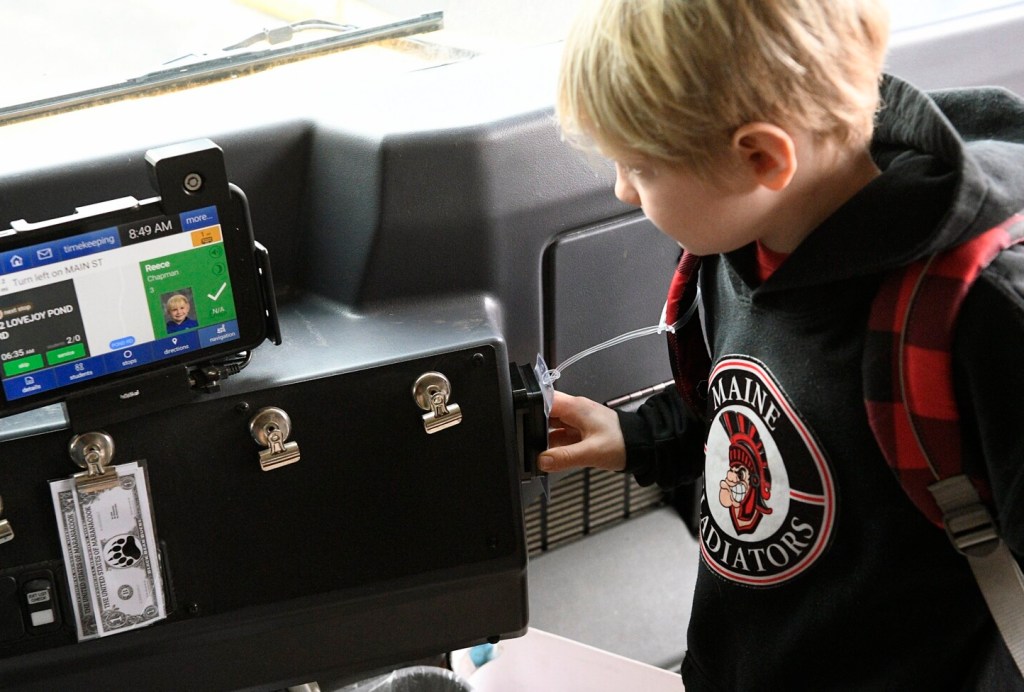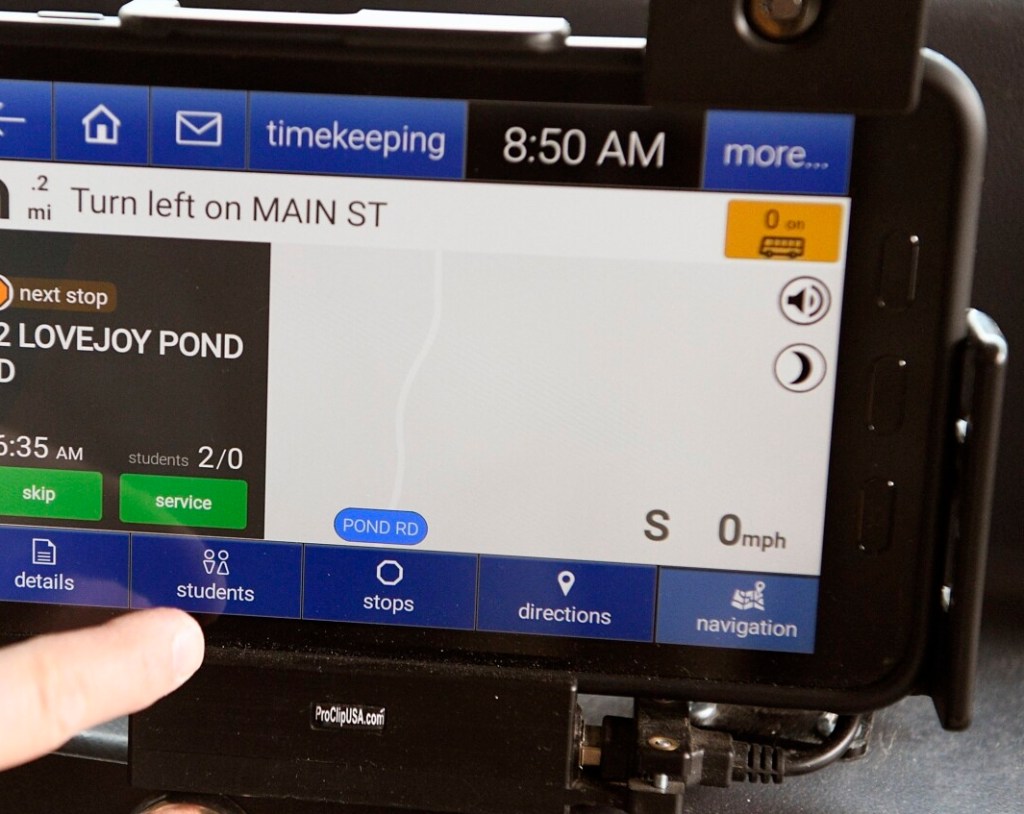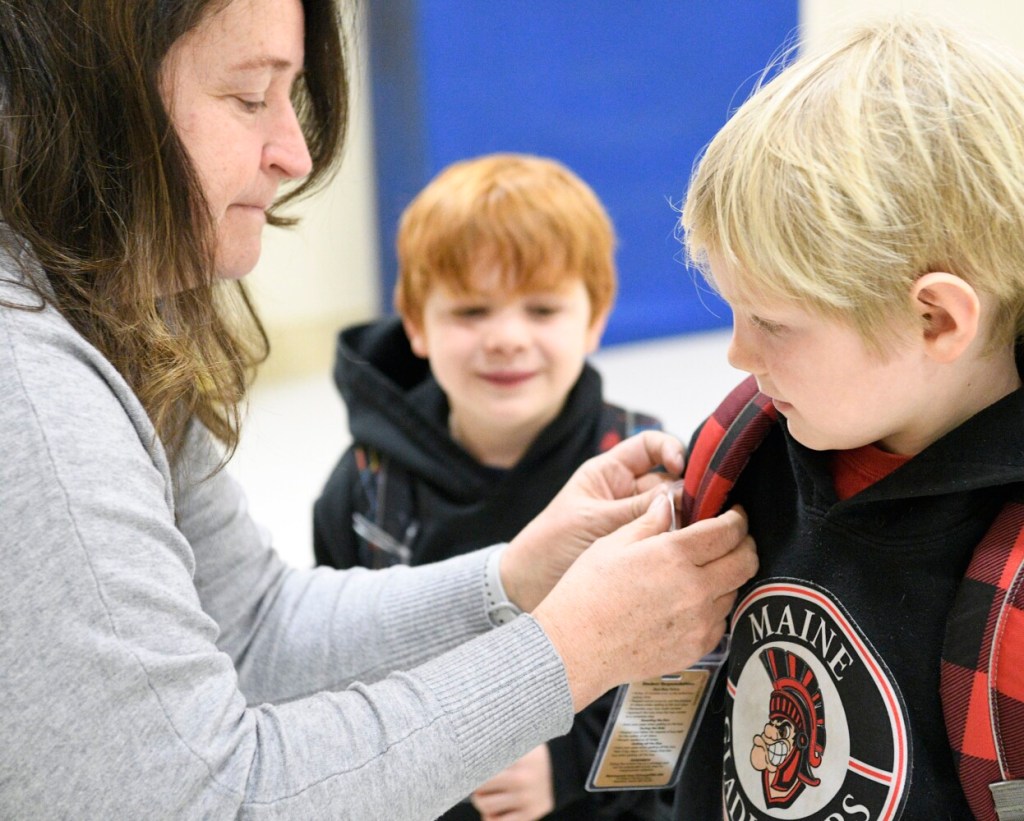READFIELD – Kelly Thompson visited students at Wayne Elementary School on Thursday to hand out key cards that included their name, photo and a barcode to scan when they get on the bus.
When scanned, the card will tell the bus driver who the student is and where to drop them off. Previously, the bus driver would manually input into a device when a student got on or off the bus. But now with the students using a card, officials say the process is easier and safer.
“They are all asking when they can use it,” said Thompson, the transportation director for Regional School Unit 38.
Wayne Elementary School has become the first school in the district to receive their key cards. The district plans to give the key cards out to every school in the district but is doing it on a day-to-day basis so Thompson and her staff can give a presentation on what to do.

Kelly Thompson, the transportation director for Maranacook Area Schools, pins Connor, left, and Reese Chapman with their new bus identification badges Thursday at Wayne Elementary School. Andy Molloy/Kennebec Journal
The technology originally was installed on the school buses to contact-trace students during the COVID-19 pandemic, according to Superintendent Jay Charette. But even after school districts stopped having to contact trace on public transportation, the technology proved to still be extremely helpful, mainly around student safety and to help solve problems around the bus driver shortage.
“With COVID-19, we really needed to find a way to know who was on the bus and for how long and the protocols related to that,” said Charette. “We really started looking and saying, ‘This is COVID-19 related, but what are the advantages to this system?’ Being able to know who is on the bus, what seat they are in and the ability to know when a student is going to be picked up or dropped off, it’s a very win-win situation and we felt it keeps everyone involved in the transportation process.”
With an iPad-like device installed on the buses to access the software, school officials and those in the transportation department can pull a report of who rode on a bus, when they were on the bus, and the duration in which they were on the bus — important factors when determining close contacts to a COVID-19 case.

Bus driver Emily Webber checks the new transportation computer Thursday at Wayne Elementary. Andy Molloy/Kennebec Journal
The technology, called Traversa and made by Plano, Texas-based Tyler Technology, has several different features in addition to tracking students. With the device, bus drivers have to do pre- and post-route inspections on the bus and check for maintenance issues. The device will track the speed of drivers and will only be able to work while the driver is stopped.
It costs the Maranacook school district about $5,500 a year for the subscription to Traversa, according to expenses listed in its budget for next year.
With the student’s key card, the device can tell who is on the bus and who is not — if a student is not on the bus that day, the device can reroute and skip the students’ stop. If the device reroutes, it will do so only on main roads and ensure the child can still leave the bus on the correct side of their stop.
With Tyler 360, another subsection of the technology that RSU 38 will roll out soon, parents can see through a smartphone app their child made it on the bus, got off the bus and when the bus is expected to arrive. Transportation directors can alert the parents of news regarding the buses, too.
According to CJ Vose, Tyler Technology’s director of sales for student transportation, 26,000 customers in more than 48 states use the bus routing system, which roughly covers 33% of students nationally.

Bus identification badges for Wayne Elementary students Connor, left, and Reese Chapman are seen on Thursday. Andy Molloy/Kennebec Journal
In the Augusta area, Hallowell-based Regional School Unit 2 has already been using the system. Transportation Director Katie Spear said in the February school board business meeting the technology was a “huge help” with COVID-19 contact-tracing, or if “for some reason someone’s child does not make it home.”
The Maine Department of Education did not immediately respond for comments this past week regarding statewide trends with bus routing technology.
When talks of installing the technology on the school buses first became a topic back in September at RSU 38’s school board meeting, board member Dane Wing raised concerns over safety and whether or not someone could hack into the system, or if parent’s access to the bus route could be worrisome. Thompson clarified at the meeting that the smartphone app does not allow parents to see the route the bus is on, but rather the time when their student will arrive at their specific stop.
Tyler Technology’s media relation’s specialist, Jennifer Kepler, elaborated on the safety of the technology, saying all data coming in and out of the Tyler data centers are monitored and recorded.
“Tyler’s Student Transportation solution is provided as a software-as-a-service solution, meaning a district does not need to own, update or safeguard computer hardware on-site,” she said. “Instead, Tyler hosts client’s data within its data centers. … All student data is encrypted in their software solutions and Tyler Drive tablets.”
Vose pointed out the technology can be helpful to combat the bus driver shortage, as well, since the routes can be modified in real time, depending on who is on the bus. RSU 38 has done relatively well compared to other districts regarding the bus driver shortage, but there has been times where routes have had to change, or a bus did not run.
“It helps in being efficient with routes,” Vose said. “There might not be the same amount of drivers (in a district), or less buses, but the same amount of children. It helps to be more efficient with routes, with giving information to drivers that might be new, or if they might not have drivers familiar with the student’s drop off locations.”

Bus driver Emily Webber teaches Wayne Elementary students about bus safety on Thursday. The Maranacook Area Schools are equipping students with identification to swipe on their buses. Andy Molloy/Kennebec Journal
Thompson said the children have acclimated well to using the key cards to scan onto the bus and were engaged on Thursday when they received the cards.
Though the children have acclimated well to the technology, Thompson said she has trained her staff “in little itty steps,” so they are able to take it on at a pace, rather than all at once. She gave the example of logging on the device one day, then changing the bus route the next day as some of her lessons.
“They were reluctant since it’s so new and very different, but they have proven to be the people they are, which is pretty darn amazing and they have embraced it,” Thompson said of her drivers. “… They understood the ‘why,’ what the ‘why’ was, and that we had to buy in because of the ‘why,’ but they have all done a good job on being open minded.”
Send questions/comments to the editors.








Comments are no longer available on this story